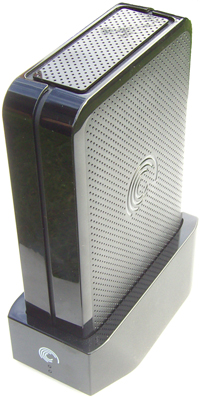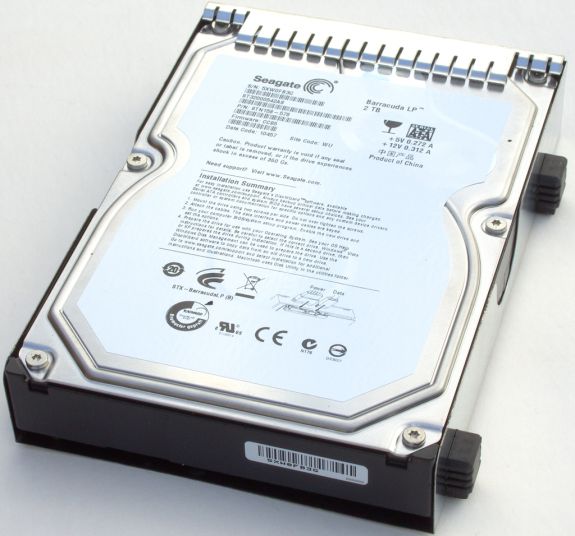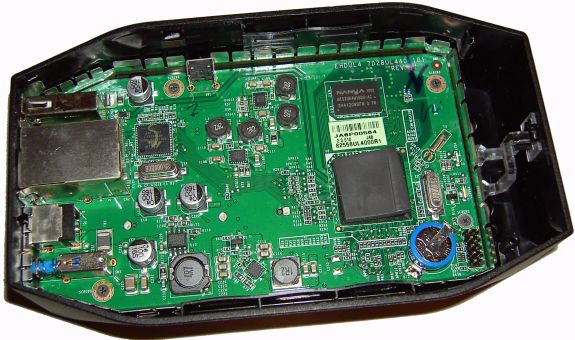Seagate GoFlex Home 2TB Reviewed
by Rajinder Gill on October 10, 2010 5:05 PM ESTAlong with the 3TB Seagate USB drive Anand reviewed last month, Seagate also sent us a NAS drive based around the same aesthetics – the GoFlex Home 2TB:

The 2TB GoFlex Home
The GoFlex Home connects via a Gigabit Ethernet port and allows all manner of media streaming, file sharing and backups across a home network or the internet with the key emphasis of Seagate's software bundle being on ease of use. 2TB of space is more than enough space to store a huge library of video and music, and more than ample to be used as a general backup device. The 2TB GoFlex Home retails around $229 - if you can’t see yourself needing that much storage, Seagate offers a 1TB version of Go priced around the $159 mark.
Let's delve staright down into the physcial stuff before we take a gander at the software package...
As with the 3TB GoFlex Desk, we managed to force the casing apart and take a peak at the drive inside:

It's a Seagate Barracuda ST32000542AS
Seagate's choice of casing was a stifling blow for the 3TB GoFlex Desk. Hopefully we won't find the same problems on the 2TB Home - we'll be taking a look at temps a little later.

The GoFlex Home docking station
Upgrading or replacing a drive at a later date is possible, although you are limited to using one of Seagate's GoFlex drives. A couple of LEDs grace the front side of the docking unit; one pertaining to connectivity and the other showing drive ready status (drive activity is not shown, unfortuantely). Although we haven't pictured the rear here, a gigabit ethernet port, USB port (for plugging in a network printer or USB drive), on/off switch and power input connectors are all located on the rear of the unit. Power is supplied by a (included) wal-wart 12V PSU.
At the heart of the Go FLexHome is a 1.2GHz Marvell 88F6281 processor (underneath the tthermal pad), teamed up with 128MB of Nanya RAM and also 500MB of flash memory. The Gigabit Ethernet port is driven by a Marvell 88E116R LAN controller.











30 Comments
View All Comments
xi0s - Sunday, October 10, 2010 - link
Try getting one of LG's NAS samples for review. Seen them on Fry's shelves but have yet to make a decision.Conficio - Sunday, October 10, 2010 - link
First thanks for all teh ahrd work you are doing here. Your tests are in depth and very informative.I'd love to see Mac OS X covered in the tests, at least some basic setup and performance.
May I also suggest a build it yourself option the Coolmax CN-390 enclosure with a printer server included for ~$70. Add a 1 TB (or 2 TB) drive and you got yourself a rather cost efficient solution.
name99 - Sunday, October 10, 2010 - link
Perhaps MacOSX isn't covered because, seriously, if you're using OSX why do you need to pay $70 extra for this sort of thing? Buy an FW800 version (maybe a $30 premium over USB), plug the drive directly into an OSX box and share it, and you have the exact same functionality. With Snow Leopard, you can even allow the server to go to sleep and it will wake when a request comes in, so it's not like there's power savings. And you have a device that's running 100% HFS+ rather than god knows what file system Seagate provide, and which, if god forbid, it becomes necessary, you can subject to fsck.Strunf - Monday, October 11, 2010 - link
If you have windows you can also share your drive so "why do you need to pay $70 extra for this sort of thing"... maybe cause the whole point of a NAS is to not be dependent on a single computer.name99 - Monday, October 11, 2010 - link
The dynamic is somewhat different for Windows.(a) Most Windows boxes don't offer FW800, and USB3 is still rare. So using this box would get you perhaps double the speed of a USB2 connection to a Windows box.
(b) I can't remember the story with WIndows support of allowing a server to to to sleep. Recall that on Snow Leopard (with an Airport Base Station) the server can go to sleep, and the base station listens for requests directed at the server and will wake it when appropriate. (All automatically, no setup necessary.)
I recall that MS has talked about this, but I can't remember if they've released it yet, or how wide a range of base stations/routers it works with. I'd guess that right now it's probably not something you can rely on.
So, like I said. On the Mac side the possible reasons to use this box (speed and power) are pretty non-existent. On the Windows side, the equation is not so strong.
Strunf - Tuesday, October 12, 2010 - link
I don't know what your speaking about this NAS sure isn't 2x faster than a USB drive, on the contrary is much slower, in writes is 4x slower than my USB drive, only the read is on pair with my USB drive.I have windows 7 and all drives go into sleep mode even the external ones, if there was a problem at some point it's not the case anymore at least not for me.
Like I said the whole point of a NAS is to be completely independent on the status of a single computer, be it with a Mac or a Windows the reasons to buy a NAS are exactly the same.
Duftopia - Sunday, September 14, 2014 - link
Be assured the drive is slower primarily due to Ethernet speed on your router, Please check that.Under normal conditions this drive runs at around 54 mb/s on a gigbit router 10/100/1000 or 2000.
The drive inside the box is slower at writing than reading which can drop the speed down to 1/2 the above mentioned speed but still remain marginally faster than a typical usb 2.0 connected external.
Duf
brucek2 - Sunday, October 10, 2010 - link
If I'm going to trust all my files to a centralized storage solution, I want that solution to have protection from a failed hard drive (and it seems most/all individual drives will eventually fail.) Perhaps cost effectiveness ruled out a RAID 5 array or similar approach at this price, but even if so that strikes me as penny wise, pound foolish.Duftopia - Sunday, September 14, 2014 - link
Your backups should be of working online files and systems. As long as you are not counting on an "Image" or any other encoding this cheap alternative serves a very useful purpose for low budget people, PLUS it comes with perks like online access, easy upgradability (as long as Seagate keeps the goflex line alive), and can remain up and running when you turn your computer off making it available to DLNA and other devices (aka Tivo) w/o a running computer.ZeframJCochran - Sunday, October 10, 2010 - link
"The GoFlex Home connects to a [bold]wireless router[/bold], and allows all manner of media streaming, file sharing and backups across a home network or the internet with the key emphasis of Seagate's software bundle being on ease of use."This implies that it is a wireless device, which lead me to be quite disappointed :(